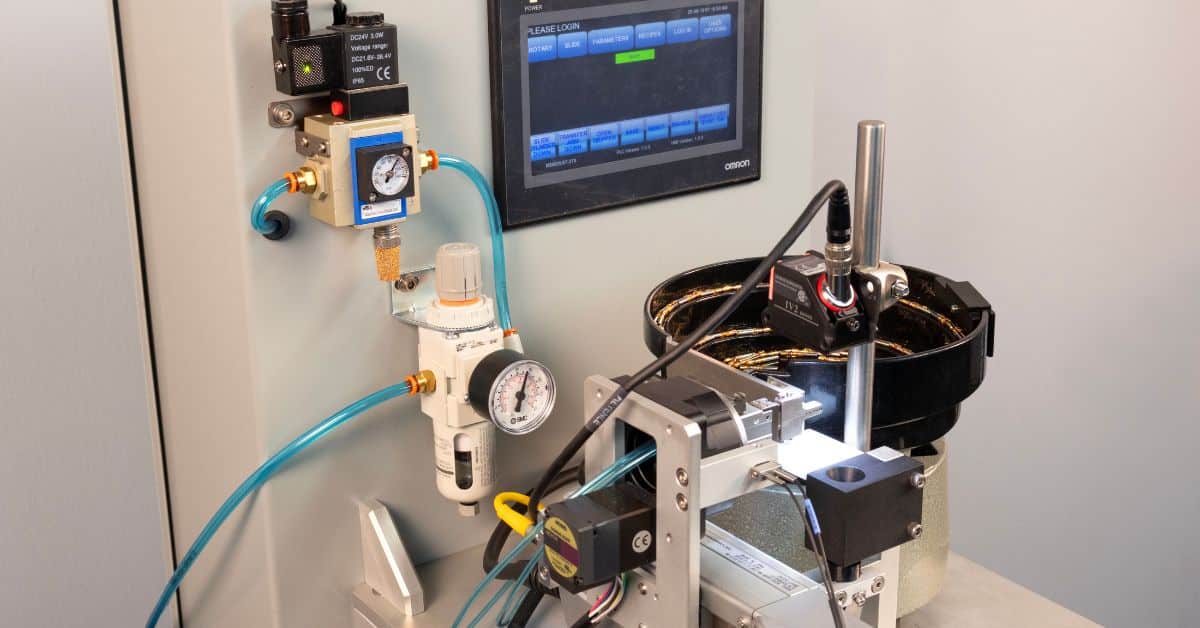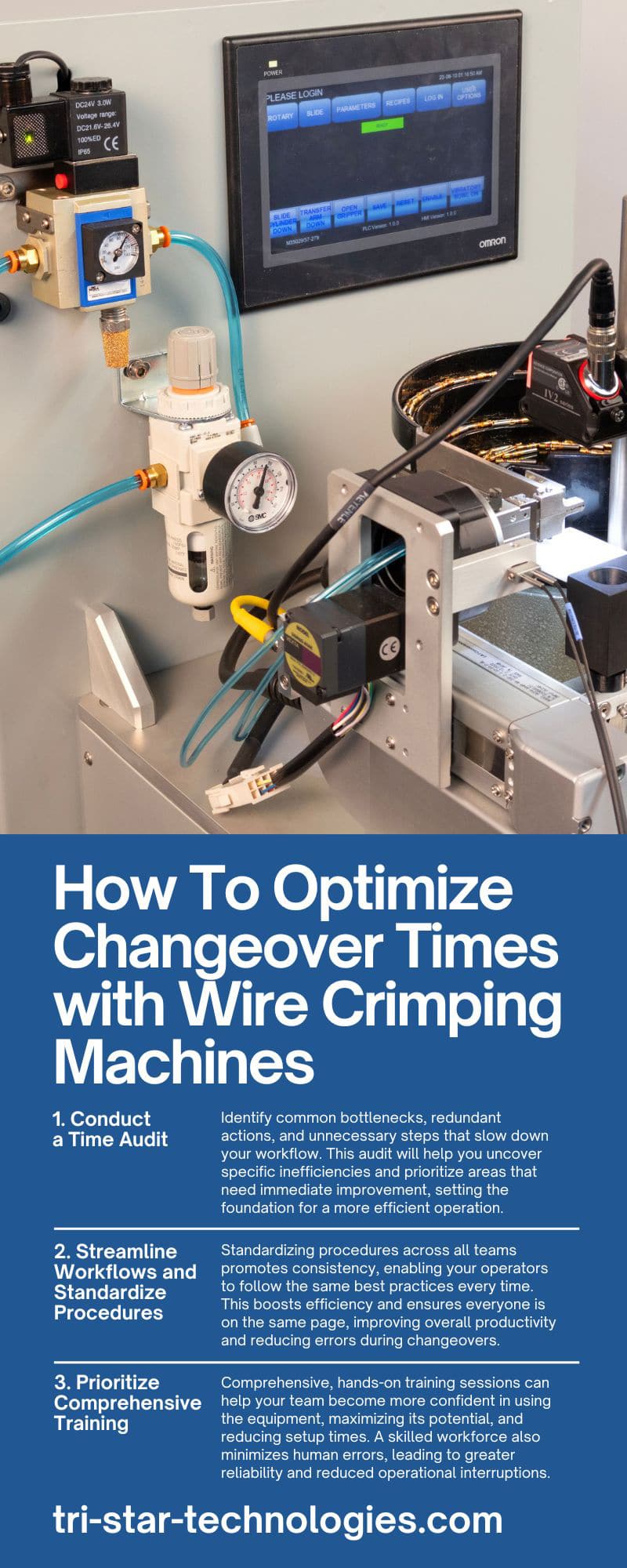How To Optimize Changeover Times with Wire Crimping Machines

Efficient production is a cornerstone of successful manufacturing. For manufacturers, operations managers, and engineers, minimizing downtime during equipment changeovers can significantly affect profitability and overall operational performance. Yet, one of the common bottlenecks in wire harness and cable assembly production is the time it takes to shift from one task to another—also known as changeover time.
For processes involving wire crimping machines, changeover delays can be especially costly, disrupting workflows and decreasing output. Fortunately, adopting the right tools, technologies, and systems can drastically reduce these inefficiencies. Keep reading to learn how to optimize your changeover times with the help of wire crimping machines.
Why Optimizing Changeover Times is Critical in Manufacturing
Changeover time refers to the period when operators must adjust equipment, tools, or processes to transition from producing one product or configuration to another. In wire crimping operations, this could involve tasks like changing contact settings, calibrating for different wire sizes, or swapping cartridges to accommodate various materials. These processes ensure the correct configuration of precision and quality in the production process.
However, extended changeover times can cause a litany of problems and headaches, from greater operational costs to lower production output and less profitability. Industries such as aerospace, automotive, and telecommunications, where both precision and high-volume production are essential, are particularly sensitive to the impact of changeover inefficiencies. By streamlining and minimizing changeover time, manufacturers can save costs and enhance operational efficiency, meet tight production schedules, and maintain competitive advantages in demanding markets.
Understanding Wire Crimping Machines and Changeover Times
In wire crimping, the time it takes to to adjust settings and calibrations is a loss, and lost time is lost revenue. Below, we explain the role of wire crimping machines in electrical assembly processes and the impact of changeover times on operational efficiency.
Wire Crimping Machines in Manufacturing
Wire crimping is an essential process in electrical assembly where hand tools or machines press connectors or terminals onto wire strands. Whether you’re working with MIL-SPEC contacts or general-purpose connectors, the quality of crimps directly affects the reliability of the final product. Wire crimping machines, therefore, play a vital role in ensuring consistent, high-quality crimps.
Traditional, manual crimping methods require extensive setup time and operator intervention, which can cause significant inefficiencies. On the other hand, automatic crimping machines streamline this process, offering faster production rates, improved accuracy, and greater consistency—all vital for large-scale manufacturing.
The Impact of Changeover Times
Changeover disruptions in wire crimping occur for various reasons, such as reconfiguring settings for different AWG wire sizes, adjusting crimp force parameters, or relocating crimpers to accommodate a new production line. Each of these activities extends the switching period, leading to delays that ripple across the production cycle.
For businesses managing numerous product types or configurations, multitasking and flexibility are crucial. Optimizing changeover times in wire crimping machines can significantly shorten downtime, allowing operators to transition seamlessly to the next task with minimal delay.
Innovative Solutions from Tri-Star Technologies
Tri-Star Technologies is a leader in advanced manufacturing solutions, specifically for wire crimping, laser wire marking, and adhesion-improvement technologies. Our suite of wire crimping machines can address one of the industry’s biggest pain points—time-consuming changeovers.
The TAC X Series
The TAC X Series is one of Tri-Star’s most sought-after models for high-volume, low-variability processes. It boasts an impressive capacity to handle up to 1,800 crimps per hour, making it ideal for manufacturers requiring precision at scale. The automatic crimper also includes vibratory bowl systems and wire-triggered operations, allowing it to deliver smooth, reliable crimps every two seconds.
Built-in safety measures, such as automatic shutoff and quality control features like bird-caging prevention, add an extra layer of reliability to the device. For organizations handling shouldered or shoulderless contacts, the TAC X offers unmatched efficiency.
The PORTA-TAC
For manufacturers managing smaller batches or having more variation in their crimping requirements, the PORTA-TAC is the epitome of flexibility. Its revolutionary “plug-and-play” magazine system enables operators to change contacts in less than a minute. This swift adaptability makes it the go-to choice for low-volume, high-variability environments.
With PLC-controlled functions and easy tool changeovers, the PORTA-TAC supports seamless transitions between tasks. Whether for first-end crimping needs or fine-tuned adjustments for different connectors, this is the consummate, easy-to-use machine.
The CR-36
The portable CR-36 simplifies hard-to-reach applications and manual crimping tasks. This model features a preloaded cartridge system, reducing setup times while allowing operators to switch wire sizes (from 16–26 AWG) effortlessly. The CR-36’s incredible versatility allows it to work horizontally, vertically, and even upside down—a game-changer in settings where mobility and orientation flexibility matter.
Integrating Optimization Strategies
While automatic crimpers can help extensively when it comes to decreasing lost changeover time, they can’t fix everything. To optimize changeover times alongside wire crimping machines, consider strategies like time audits, comprehensive training, and more.
1. Conduct a Time Audit
Start by thoroughly analyzing your current changeover process. Take the time to observe operations closely and document each step.
Identify common bottlenecks, redundant actions, and unnecessary steps that slow down your workflow. This audit will help you uncover specific inefficiencies and prioritize areas that need immediate improvement, setting the foundation for a more efficient operation.
2. Streamline Workflows and Standardize Procedures
After identifying inefficiencies, redesign your workflows to eliminate unnecessary steps that waste time or resources. Streamlining workflows ensures smoother transitions between tasks, reducing delays and confusion.
Standardizing procedures across all teams promotes consistency, enabling your operators to follow the same best practices every time. This boosts efficiency and ensures everyone is on the same page, improving overall productivity and reducing errors during changeovers.
3. Prioritize Comprehensive Training
Your operators play a critical role in achieving efficient changeovers, so their training should be a top priority. Ensure you fully train team members on their machines, including how to execute quick setups, adjust settings precisely, and troubleshoot common issues effectively.
Comprehensive, hands-on training sessions can help your team become more confident in using the equipment, maximizing its potential, and reducing setup times. A skilled workforce also minimizes human errors, leading to greater reliability and reduced operational interruptions.
4. Leverage Predictive Maintenance Technologies
Take full advantage of the advanced built-in monitoring systems in Tri-Star’s machines. These systems continuously track performance and detect potential malfunctions early, allowing you to address issues before they turn into major problems. Proactively establishing a predictive maintenance schedule is essential for keeping your equipment in top working condition.
Regular maintenance extends the lifespan of your machinery and reduces the risk of costly, unscheduled downtime. By integrating predictive maintenance into your routine, you can prevent disruptions and maintain optimal productivity. By following these strategies, manufacturers, operations managers, and engineers can effectively implement innovative solutions and optimize operational performance.
Enhance Your Work Efficiency with Tri-Star Technologies
Lengthy changeover times don’t have to be a costly challenge for manufacturers. By integrating advanced equipment like Tri-Star Technologies’ wire crimping machines, you can significantly reduce downtime while boosting flexibility and output quality.
If you’re ready to enhance your operational efficiency, Tri-Star Technologies is here to help. Browse our collection of wire marking machines online, or contact our expert staff if you have any questions about how our equipment can improve your process.



